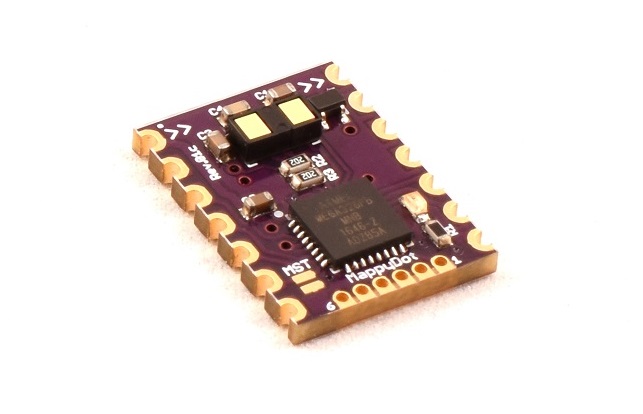MappyDot+ - A Smarter Micro LiDAR Sensor
MappyDot Plus is a highly accurate laser time-of-flight ranging sensor which provides system designers with the ability to measure highly accurate distances on platforms such as drones and robots, for collision avoidance, area mapping, distance measurement, gesture recognition, user detection and motion sensing. The MappyDot Plus uses the VL53L1x laser time-of-flight ranging sensor from STMicroelectronics, which is a 940nm Class 1 (eye-safe; IEC 6082501:2014) laser sensor, in conjunction with an on-board controller to provide a huge range of features. Use the MappyDot Plus to prevent your drone from colliding with objects or to optimise its landing, make star trek like door laser ping sensors to open doors automatically or even create unique musical instruments.
Each MappyDot Plus can provide distance measurements up to 4 meters (in mm) and a non-interpolated rate up to 100Hz, with a programmable field of view (from 15 to 27 degrees) and region of interest selection, without additional optics. It also offers better ambient light immunity (in certain modes) over the MappyDot. Multiple MappyDot Pluses can be chained together easily to gather multi-dimentional data about an area, without reducing sampling rate due to processing overheads . They are also calibrated out-of-the-box to within ±1mm and can be easily re-calibrated if integrated into a commercial enclosure. The MappyDot Plus also performs low pass filtering on the motion data that arrives from the sensor, to provide you with the clearest picture of the environment around it. This is all in addition to the standard features that SensorDots provide.

While the MappyDot Plus provides a nice, easy to use footprint for developers, it also makes it easy for you to develop for. Upon first power up, the MappyDot Plus allows users to obtain an accurate, up to date position with two lines of Arduino code at any time:
Wire.requestFrom(address, 2);
distance = Wire.read() << 8; distance |= Wire.read();
It's really that simple. No special libraries to load, just read a value. The distance measurement leg work is done entirely by the module. Leave all the extra CPU cycles and code writing to the important things.
Each MappyDot also offers the following user selectable distance measurement modes in single or continuous modes (through additional I2C commands):
- Short up to 1.3m (Better Ambient light immunity)
- Medium up to 3 m
- Long up to 4 m
- Each mode has a configurable measurement budget (between 20 and 1000ms) which lets you specify the desired accuracy vs speed.
However, if your application requires something more complicated, more lower level I2C commands are available, or you can always tweak and update the open-source firmware as you please via the, I2C bootloader, even after soldering or mounting the modules.